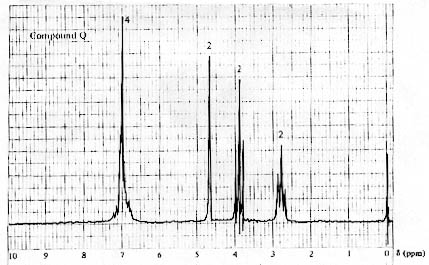
Final Exam Chem 3045x 1996
1. (20 Points) Suggest a plausible synthesis for the indicated compounds employing the indicated starting material and any inorganic or organic reagents you need in addition to the starting material. More than one step may be required for a plausible synthesis.


2. (20 Points) Suggest a plausible structure for C4H8 (A) and C10H16 (B) based on the indicated reactions. Be sure to indicate pertinent stereochemistry in the structures you suggest.


3. (20 Points) Under certain conditions, the nitration of benzene follows the rate law: rate = k[HNO3]. Which, if any, of the following is a possible rate determining step under these conditions? Explain your reasoning.
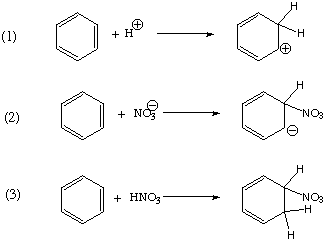
(3) since the rate determing step must consist of species that appear in the rate equation.
4. (20 Points) Three different dibromobenzenes (A, B and C) are known. Each is further brominated with Br2/FeBr3. Deduce the structures of A, B and C from the following information and explain your reasoning.
(1) A yields 2, and only 2, tribromobenzenes
(2) B yields 3, and only 3, tribromobenzenes
(3) C yields 1, and only a single, tribromobenzene
5. (20 Points) Identify the more stable stereoisomer in each of the following pairs and give the reason for your choice:
1,2-di-equatorial is better than 1-equatorial-2-axial; thus we have
(a) cis-1-isopropyl-2-methylcyclohexane or trans-1-isopropyl-2- methylcyclohexane

(b) cis-1-isopropyl-3-methylcyclohexane or trans-1-isopropyl-3- methylcyclohexane

6. (20 Points) Which of the following compounds, if any, are chiral? Explain your reasoning for full credit.
|
(a) cis-1,2-dichlorocyclohexane |
cis-1,2 = 1-equatorial-2-axial |
|
(b) trans-1,2-dichlorocyclohexane |
with a given conformation, there is no mirror plane |
|
(c) cis-1,3-dichlorocyclohexane |
(c) has a mirror plane across the molecule:  |
|
(d) trans-1,3-dichlorocyclohexane |
trans-1,3 = 1-equatorial-3-axial
|
7. (20 Points) Compound A (C7H13Br) is a tertiary bromide. On treatment with sodium ethoxide in ethanol, A is converted to a hydrocarbon B (C7H12). Ozonolysis of B gives C as the only product. Deduce the structures of A and B.

8. (20 Points) Which of the following bromides will undergo nucleophilic substitution more rapidly under SN1 conditions? Explain your reasoning.

SN1 involves formation of carbocation, which an electron-donating group can stablize:

An electron-withdrawing group, as you may expect, destablizes the cation.
Thus (B) undergoes SN1 much faster than (A).
9. (20 points) Imagine molecules that existed in "Flatland", that is, in a two dimensional space. Translating the ideas of chirality in three dimensional space to two dimensional space, which, if any, of the following molecules are chiral in "Flatland"? Explain your reasoning.

(A) = chiral
(B) = achiral since there is a mirror plane:

(C) = chiral
(D) = achiral since there is a mirror plane:

10. (20 Points) Employing Hückel theory and resonance theory, predict whether protonation will occur more favorably on the oxygen atom or the nitrogen atom?

Protonation occurs more favorably at oxygen since a resonance form with 6 p electrons (HUCKEL'S AROMATICITY) can be drawn.
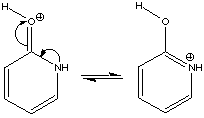
11. (20 Points) Consider the two tertiary bromides, A and B. One of these bromides is very reactive to elimination under basic conditions and is also reactive to nucleophilic substitution under acidic conditions,while the other is completely inert to both elimination and substitution under the same conditions. Which bromide is inert and why?
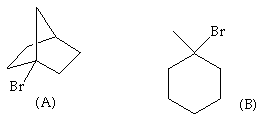
(A) is inert because:
1. carbocation formation is not favorable.
The cabocation has to be flat. However, by making the cation flat, the molecule needs to undergo unfavorable conformational change with significant increase in internal strain.
2. Elimination with the resulting alkene violates the Bredt's Rule:
The substituents on either side of the alkene should be on the plane, not perpendicular as drawn above.
12. (20 Points) Treatment of the alcohol A with sulfuric acid yields the alkene B. Suggest a plausible mechanism for this reaction.

13. (20 Points) Consider that the infrared carbonyl stretching frequencies of the three compounds A, B, and C are quite different. Based on your knowledge of resonance theory and infrared spectroscopy, predict which will have the highest carbonyl stretching frequency and which will have the lowest carbonyl stretching frequency. Explain your reasoning.
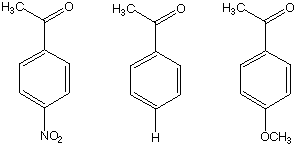
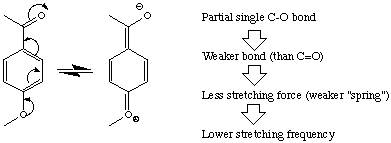
14. (20 Points) Suggest a plausible structure for a compound, C8H10O, possessing the IR and 1H NMR spectra shown below. The numbers next to the signals in the NMR spectrum correspond to the number of protons associated with the signals.
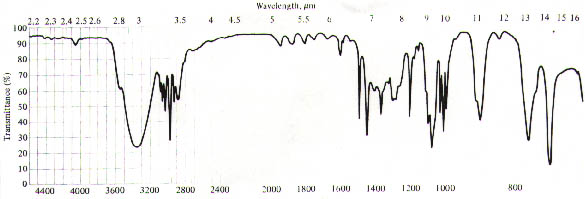


15. (20 Points). Suggest a plausible structure for a compound, C9H10O,possessing the 1H spectrum shown below. The numbers next to the signals correspond to the number of protons associated with the signals.
